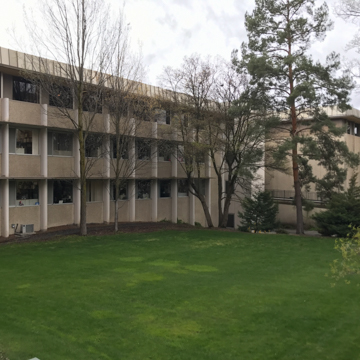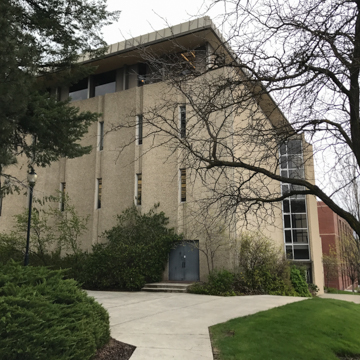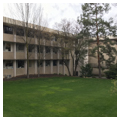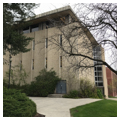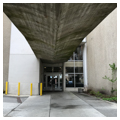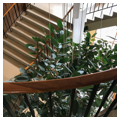Cleveland Hall marked the conclusion of a brief flurry of construction and planning in the 1950s and early 1960s that departed from the characteristic red brick exteriors of the historic core and shifted the orientation of campus buildings away from the city of Pullman below. Cleveland Hall is arguably the most architecturally distinctive of a series of buildings, including Heald Hall and Fulmer Annex, to follow this pattern. Each of these buildings was set back from College Avenue by bridges, stairs, or landscaping, mirroring a larger trend in American architecture and urbanism to set buildings away from the traditional streetline. Cleveland Hall is also one of the few pre-1970 academic buildings at Washington State University to have served a single purpose since its inception: as a dedicated building for the discipline of education.
Designed by Seattle-based Burkhard and Associates, the predominantly crushed rock, concrete aggregate, and glass 61,000-square-foot building—essentially three interconnected volumes in one—occupies a small ravine just northeast of the corner of College Avenue and Idaho Street. Cleveland Hall’s volumes and articulation essentially illustrate its general functions: equal-sized windows and horizontal bands of concrete signal the office wing on the east side; a mostly concrete wall with slit windows, a clerestory, and a glass-enclosed stair tower mark the lecture halls, classrooms, and library on the west side. The complex is meant to be approached via a reinforced concrete, gently arched bridge that spans a landscaped courtyard and bisects the office and classroom volumes at the second floor.
The bridge leads to a large-windowed, three-story public atrium, the full sweep of which is experienced through an open spiraling staircase that encircles an enormous Ficus elastica plant (India rubber tree) that reaches nearly to the ceiling of the three-story building. The plant itself has long enveloped a dramatic three-story light fixture of midcentury modernist design, its thin, original dangling light shades are today best seen in period photos but, as of 2017, can be discovered hanging from ropes entangled within the plant’s leaves on the first two floors and seen more clearly from the third floor. According to an article in the WSU Daily Evergreen published shortly before the building’s completion, the furnishings and color schemes for Cleveland Hall were selected by the architect’s wife, who served as the interior decorator. The lighting in the building overall earned it some notoriety as the first structure in the Pacific Northwest to meet the criteria for “good school lighting conditions” as established by the American Standards Association.
Cleveland Hall was completed for $1,499,000 in 1963 and dedicated in May 1964 in honor of Alfred A. Cleveland, the first dean of what had become the College of Education. Spaces for education instruction at the university were previously in temporary buildings located just to the north, and prior to that within College Hall. Upon its opening, the building also housed the Philosophy and Psychology departments. Cleveland Hall was also built with a closed-circuit television studio intended for educational broadcasts, an air-conditioning system, and lecture halls with folding desk tops on the chairs; according to the Daily Evergreen, some of the chairs were “designed for left-handed students.” These were apparently among several “firsts” at the university.
Burkhard’s name is not associated with any other building at WSU, although his firm may have been chosen to design Cleveland Hall because it had completed the College of Education at Central Washington University just two years before. Cleveland Hall was planned originally as a three-story asymmetrical structure, but the $600,000 third story was not completed until 1968. In 2005, a new building for the college, designed by Hacker Architects of Portland, was completed to the south and a connecting bridge was extended from Cleveland Hall’s second story on the south side.














